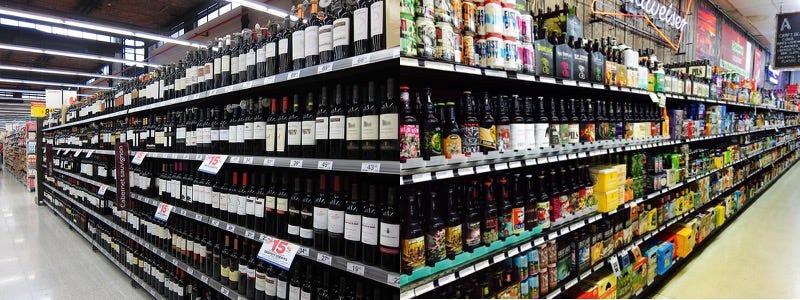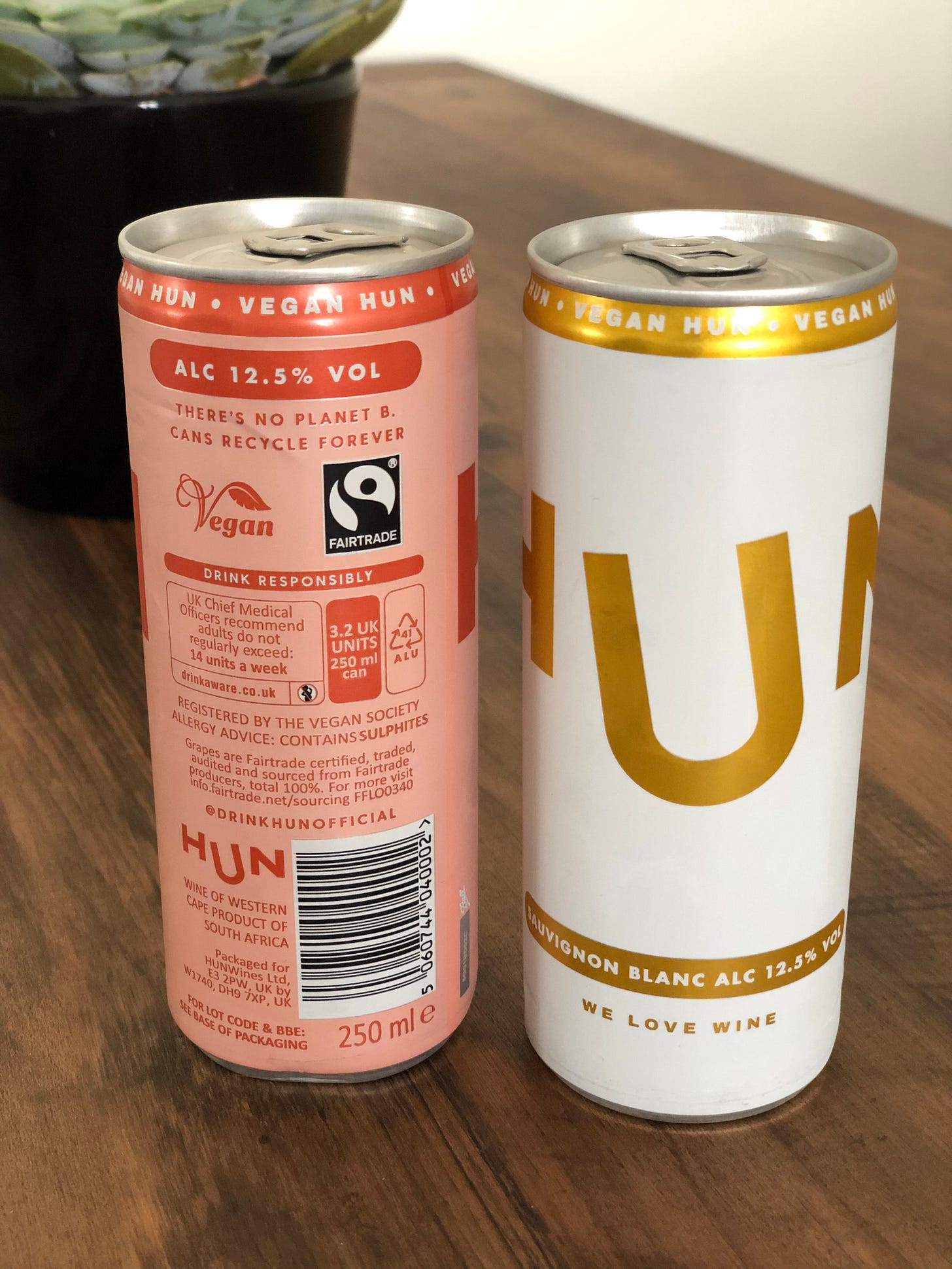Cans must be the future of wine
For the sake of the industry as a whole
The wine industry is not in a great place. Despite what we, generally as insiders or prosumers believe, the industry is in decline particularly among the younger demographic who are just entering adulthood and getting set in their tastes and likes.
Across nearly every measure still wine sales in the UK have been declining or at least stagnant with volumes falling by 2% over 2016-17 and predicted to fall by 11% over the next 5 years [1]. This is despite overall alcohol consumption increasing by around 7% [2], beer sales increasing by 2.6% in 2018 [3] and spirits expected to grow by over 5% over the next few years [4]. Even the saving grace of the wine industry in the UK, Prosecco, has stagnated with sales peaking in 2016/17 [5].
For many in the wine industry and those like me who are reasonably large consumers this might come as a shock. We know that there’s huge variety out there and some amazing wines coming out of almost every region. For the general consumer though this isn’t always the case. When you think about it wine is not very accessible at all.
For the general consumer wine is confusing, boring, inconvenient, expensive, bad for the environment and generally not an easy market to enter. The average monthly wine consumer is 50 years old and has an income around 25% above the national average [6]. If you as a young Millennial or Gen Z wanted to start exploring wine it’s not a particularly attractive or trendy market to get in to. Unlike perhaps craft beer which has grown phenomenally over the last 10 years thanks to its trendy image and accessibility. Just compare the demographics and atmosphere in your local craft beer bar compared to your local wine bar.

Image: Mother Kelly’s Craft Beer bar in London
This is all something that canned wine can help to overcome, and what I want to start discussing through this post.
Get new posts directly in your inbox. No spam, no marketing, just great posts.
Marketing
Walk down the beer or spirit aisle in the supermarket and you’ll be awash with different colours, brands, sizes, shapes, and old vs new. Walk down the next aisle, the wine aisle, and you’ll be awash with plain white labels, perhaps a picture of a chateaux, and names you’ve never heard of. Unless you have a pretty deep knowledge of wine it’s almost impossible to distinguish bottles with most consumers using price as their only guide. How many consumers know their Italian DOCGs vs DOCs vs IGTs?

Image: The wine aisle vs the beer aisle
Wine needs a serious overhaul of its marketing and appeal to a broader and younger audience. On supermarket shelves the only way to stand out is through packaging and cans give marketers a brilliant estate to attract the eye of the shopper. Research by Nielsen shows that best in class packaging can lead to over 40% increase in sales while 64% of consumers try a new wine product simply because the packaging catches their eye.
The 360 degree full length labelling on cans gives a huge opportunity for producers to stand out. More interesting, colourful and creative packaging also has secondary effects for marketing with consumers much more likely to share images of these products on Instagram. Today’s products need to be #Instagramable.

Image: Hun Wines are #Instagramable
Convenience
Take a stroll in your local park on a sunny afternoon and you’ll see an abundance of cans and beer bottles, you’ll probably not see so many wine bottles though. Traditional 750ml wine bottles are inconvenient. They may not be suitable for some places such as pools and beaches where glass is dangerous and banned. They’re heavy to carry and you need additional items to open and consume - bottle openers and wine glasses. The consumer also has to finish the whole bottle in a relatively short period of time to maintain freshness and temperature, nobody wants to drink a warm Sauvignon Blanc after all.
Cans get around of a lot of these challenges. You don’t need to worry about remembering your cork screw, cans can be taken almost anywhere without risk of breakage, they’re much lighter than bottles and give consumers a perfect serving size without needing to worry about freshness. Most cans tend to be 200-250ml, around 1-1.5 traditional servings.
Closely linked to convenience and portability is occasions. When wine becomes more convenient to consume people will consider it for a much broader set of occasions. Cans open up wine to be consumed in new places and during more active pursuits such as walking, golf, poolside parties and events, boating, theme parks and so on. This means that canned wine isn’t taking away from traditional sales but adding to them.
Cans are also an inert environment with no UV penetration or Oxygen exchange that you would usually get in a glass bottle. Techniques used for canning wines guarantee quality for up to 5 years.
The Environment
Climate change is by far the biggest threat we face today and while businesses in nearly every sector are adjusting their practices to help reduce the threat, as far as I can see the wine industry is doing little to nothing. However, it could be very easy for the industry to play its part. A study conducted in the UK found that transporting the same total volume of packaged wine in 250ml cans has half the CO2 emissions of wine transported in traditional glass bottle packaging.
Aluminium is 100% recyclable and can be recycled time and time again, indefinitely. This makes aluminium cans the most sustainable beverage packaging available.
Sustainability and the environment is something the consumers take extremely seriously now, particularly those in the younger demographics. Research suggests that the majority of consumers are willing to pay more for sustainable products and packaging while 51% of Millennial consumers check product packaging for sustainability claims before purchasing.
For the wine makers, importers and retailers there’s also savings to be made by adopting more canned wines. Lighter weight during shipping and handling, reduced breakage and more efficient stacking can save 15-20% of costs across the supply chain.
Variety
The smaller portion that consumers get from a can means they can try a much broader variety of wines in a single sitting. So for example across a three course meal a consumer could have three different wines without having to worry about opening a new bottle each time. It’s fair to say that most people will have a single bottle with a meal, across all courses, with canned wines they can have a different wine with each course without needing to use a specialist device such as a Coravin or other preservation tool.
The general trend towards faster and more informal dining also lends itself to canned wines where a consumer simply doesn’t have the time to finish a whole bottle. When dining with friends and family in larger groups they can also save the debates on which bottle to have with everyone in the party being able to choose their own can, just as you would today with choosing a beer.
Conclusion
There’s a lot of factors in favour of wine makers adopting cans, at least to some extent. This offers them the opportunity to innovate their brand and attract a new range of diverse consumers buying wine for all sorts of occasions. Cans don’t need to detract from traditional bottles sales, they can add to it.
A broad spectrum of wine makers have already started to adapt. From Francis Ford in California to Scarpetta in Italy to Hun Wines in the UK. Hun are a great example of a new brand taking full of advantage of everything discussed through this post. Their cans are attractive, they have a big Instagram presence and they actively promote their environmental credentials on their cans from them being Vegan to their cans being endlessly recyclable.

Image: Hun Wines showing their environmental credentials.
While I don’t think we’re ever going to see, or even should see, a Bordeaux 1er Cru Classe in a can we should certainly embrace and encourage wine makers to adopt cans, for the sake of the industry as a whole.
Nearly every industry has been disrupted by new innovations. Those that adapt survive and those that don’t die. Wine is no different.
Get new posts directly in your inbox. No spam, no marketing, just great posts.
Sources
[1] https://www.thedrinksbusiness.com/2019/03/uk-sees-wine-decline-and-its-predicted-to-worsen/
[3] https://www.siba.co.uk/SIBA-British-Craft-Beer-Report-2020.pdf
[5] https://www.ft.com/content/a3172278-2a3f-11ea-bc77-65e4aa615551
[6] https://www.wineintelligence.com/schrodingers-millennial/


